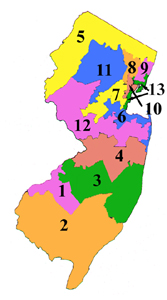| New Jersey’s Political Lineup
|
Redistricting Deadline Congressional redistricting is required to be done by January 15, 2002 or within three months of receiving census information. Legislative districts must be drawn within one month of receiving the census count. Public Access The state constitution provides that there be at least three open meetings held for the public. The final plan is also open. | Who’s in Charge of Redistricting? The Redistricting Commission is responsible for drawing congressional district boundaries. The commission is made up of 13 members. The speaker of the General Assembly, the president of the senate, the minority leaders of both houses and the chairpersons of the two largest political parties in the state must each appoint two members. The thirteenth member is chosen by majority vote of the appointed twelve. The 10-member Apportionment Commission handles state legislative districts. Its members are chosen evenly by the chairpersons of the two largest political parties in the state. There is no gubernatorial veto power for either the state or congressional plans. | ||||||||||||||||||||||||
Districting Principles
| Legal Issues The congressional plan created by the New Jersey Apportionment Commission was challenged on grounds that the New Jersey legislature could not delegate its duty to redistrict. The State Supreme Court found no federal or state prohibition against the delegation of the legislature's lawmaking authority to a temporary commission. As long as the legislature retained ultimate control, the fact that the legislature does not vote on the plan does not violate any law. | ||||||||||||||||||||||||
Political Landscape The Democrats controlled the state legislature for most of 1991, but lost it in a huge Republican gain in the November 1991 elections. Facing a veto-proof majority, the Democrats passed a bill to use a commission to draw congressional districts as well as state legislative districts. The new plan wasn't as friendly to Democrats in the early part of the decade as the prior plan, but they still control half of the U.S. House seats. Republicans still have a majority in both state legislative chambers and now have the governor's mansion. New Jersey’s bi-partisan commission approach helps to blunt the majority’s power to roll over the minority party in the redistricting process, however. Its approach provides a degree of partisan fairness in redistricting, although it hasn't resulted in many competitive districts. | Legislation/Reform Efforts In 1995 the state Constitution was amended to require a commission which is comprised of 13 members, 12 partisan and 1 tiebreaker. During the 1990s, the current plan has virtually ensured that the outcome in the overall New Jersey U.S. House delegation is split between Republicans and Democrats fairly evenly. While this may reflect New Jersey’s overall political leanings, it also means that most districts are weighted to safely favor one party over another, limiting electoral competition. |
Irregularly Shaped District | Irregularly Shaped District | Irregularly Shaped District |
|
|
|
· Central—parts of New Brunswick, Long Branch, Asbury Park · Very suburban · Competitive, bellwether district at start of decade, but now leans more clearly to Democrats · 82% white; 11% black; 5% Asian; 6% Hispanic | · North and central · 1992 redistricting removed urban, industrial, and Democratic city of Elizabeth out of the 7th · Held by Republican, but leans slightly Democratic and Democratic at local level and lean · 84% white; 10% black; 5% Asian; 5% Hispanic | · Parts of Jersey City and Newark; covers parts of New Jersey coastline · Diverse community of Hispanics, Russians, Indians, Koreans, and Filipinos · Heavily Democractic · 67% white; 14% black; 5% Asian; 41% Hispanic |
Contact Information Frank Parisi |



